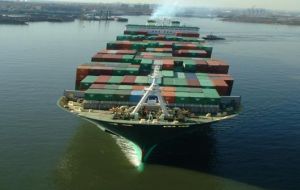MercoPress. South Atlantic News Agency
For second time in a decade India/Latam trade in 2012 was down
 Crude and raw materials are the main Indian import from Latinamerica
Crude and raw materials are the main Indian import from Latinamerica India's trade with Latin America has gone down in 2012 in comparison to 2011. This is the second time the trade went down in the last decade when it was steadily growing. The earlier decline was in 2009 at the height of global crisis. Trade with the top seven countries of the region declined 15% from 25.274bn dollars in 2011 to 21.302bn in 2012.
Fall in India's exports to the region was marginal. Exports to the top seven destinations of Latam were 11.169bn as against 11.267bn in 2011.
Imports from the region went down significantly. Imports from the top seven countries of the region decreased by 27% in 2012 ( 21.302bn) from 2011(25.274bn)
Argentina which had been the third largest destination ( corresponding to its position as the third largest market of the region) slipped down to sixth position with just 573 million dollars.
Exports to Colombia crossed the billion dollar mark for the first time with 1.042bn dollars. Colombia is number three for Indian exports after Brazil (5.043bn) and Mexico (2.698bn).
Peru was the fourth largest destination with 742 million dollars and Chile climbed to fifth rank with 658 million.
The highest increase in exports in 2012 was in the cases of Chile (64 %) and Peru (45%).
Ecuador overtook Venezuela as the seventh largest destination with 231 million dollars as against 182m for Venezuela.
Exports to Brasil and Venezuela went down in 2012. Exports to Brasil were 5.043bn in 2012 down from 6.080bn in 2011. Exports to Venezuela declined to 182m in 2012 from 196m in 2011. Exports to Argentina increased only marginally from 560m in 2011 to 573m in 2012.
Highlights of India's imports from Latin America in 2012:
Brazil remained as the top source of imports with 5.577bn dollars, up from 3.2bn in 2011. Crude oil and raw sugar were the major imports.
Imports from Venezuela declined to 3.989bn from 5.167bn in 2011. Crude oil was the main import.
Imports from Mexico increased to 2.833bn from 1.770bn in 2011. Crude oil was a significant part of the imports.
Imports from Chile (copper mostly) increased to 2.637bn from 1.780bn in 2011 while imports from Argentina (soy oil) went up marginally to 1.264bn from 1.210bn in 2011.
In terms of total trade, Brasil retained its position as India's largest trading partner with 10.620bn followed by Mexico, 5.531bn and Venezuela 4.171bn.
Some explanations:
Exports to Argentina and Venezuela suffered from local restrictions, controls and policy uncertainties. These are the only two countries which have gone back to the bad old system of foreign exchange controls. Brazil has become slightly protectionist in trade and its GDP growth in 2012 was around just one percent.
In contrast, Mexico, Colombia, Chile and Peru (these four have joined together and formed Pacific Alliance recently) follow open foreign trade policies. Their macroeconomic policies are more stable, predictable and pro-business.
Peru is the latest rising star in growth and investment. Colombia's prospects are brightening with their control over the guerrilla and drug cartels and pursuit of pragmatic policies. Mexico has become more optimistic and confident after having regained its manufacturing and exports growth. The new young and dynamic President Enrique Peña Nieto has raised the expectations even more. Chile has, of course, remained as the most stable and best managed economy of the region.
What about Central America?
Foreign trade data of 2012 for some Central American countries are not available yet. India's trade with this sub region has been growing steadily in recent years.
Action?
Of course, India needs to analyse the reasons for the unexpected fall in exports to Latin America in 2012. The region had, after all, shown GDP growth of 3.1 % in 2012 unlike Europe, US and Japan which had been grappling with recession, weak growth and lots of other problems.
Latin America is projected to grow by 3.8% in 2013 and is set on the course of sustaining the growth in the years to come. Indian business needs to intensify its focus and take advantage of the opportunities in this promising region of growth and prosperity. The business from the New Latin America and the New India are discovering new synergies and complementarities as they interact more and more with each other.
By R. Viswanathan - is a Senior Latin American Studies Fellow and the former Ambassador of India to Argentina, Uruguay and Paraguay (2007-12), Venezuela (2000-03) and the first Consul General in Sao Paulo (1996-2000).




Top Comments
Disclaimer & comment rules-

-

-

Read all comments“Chile has, of course, remained as the most stable and best managed economy of the region.”
Feb 25th, 2013 - 03:03 pm 0Thank you for the Indian perspective Mr Viswanathan.
“Exports to Argentina and Venezuela suffered from local restrictions, controls and policy uncertainties. These are the only two countries which have gone back to the bad old system of foreign exchange controls.”
Feb 25th, 2013 - 06:10 pm 0Ain't that the truth!
Why always amazes me about the trolls on this site is that they hone in on certain articles and forget others. Amazingly they have missed an absolutely scathing article on Argentina's economic policies and proof that Argentina is slowly sliding down the scale and falling behind.
Feb 26th, 2013 - 11:51 am 0I've been predicting Colombia will eventually displace Argentina as the regions's second largest and most influential country after Brazil. It is South America's sleeping giant.
Commenting for this story is now closed.
If you have a Facebook account, become a fan and comment on our Facebook Page!